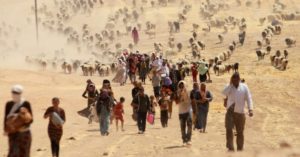Evidence grows for climate driven migration
 From island nations in the Pacific being subsumed by the rising seawater to drought-wracked pasts of Africa, there’s a growing body of evidence linking migration and climate change.
From island nations in the Pacific being subsumed by the rising seawater to drought-wracked pasts of Africa, there’s a growing body of evidence linking migration and climate change.
In a speech earlier this year, United Nations Secretary-General António Guterres warned that ”as regions become unliveable more and more people will be forced to move from degraded lands to cities and to other nations’’.
And a recent report from Oxfam found that more than 20 million people a year have been displaced by extreme weather events since 2008, mostly in developing countries.
The number of migrants across the world is currently at a record high of 244 million people, according to UN data from 2015.
They are the victims of war, dire poverty, and, increasingly of worsening environmental conditions brought on by climate change.
But the link between migration and climate change is complex because the movement of people can be the result of several interrelated and concurrent ‘push’ and ‘pull’ factors.
For instance, there are almost two million people displaced in north eastern Nigeria.
Climate change is an obvious factor with Lake Chad, the region’s main water source, slowly drying up as the Sahel Desert expands from the north.
But at the same time, the extremist militia group Boko Haram has been attacking villages and kidnapping people in the regions which had already seen poverty and food insecurity.
And new research now shows that climate driven diasporas may not be a new phenomenon.
Researchers at the University of Freiburg, in Germany analysed 19th-century migration patterns from central Europe to North America and found climate change may have played a major role in spurring mass movements of people over the centuries.
In 1800s, about five million people migrated what is now south west Germany to North America.
The study, published recently in the journal ‘Climate of the Past’ found that up to 30 percent of those people moved because of climate disruptions.
Lead author Professor Rüdiger Glaser said the figure was much higher than expected and that research on historic migrations has tended to overlook climate change.
‘‘I was surprised, to be honest. ‘The 19th century is a period with remarkable changes in the climate, economy, and politics. This is like a case study of learning how system change works,’’ Prof Glaser said.
The study showed an historical precedent for a pattern that is familiar today with unusual weather patterns followed by crop failures and then by economic instability and a mass exodus.
The study’s window of time, from 1812 to 1887, was a transitional period in climate history known as the ‘Little Ice Age’ when global temperatures were much cooler than today.
As temperatures began to heat up in response to what we now know to be man-made global warming, it was a time of climatic volatility with years of drought interspersed with crop-killing cold snaps, the study says.
And while this climate change was different to what the world is experiencing now, the impacts were similar.
The study identified a few migration peaks through the century, then matched those to historical records of weather, harvests and prices for local staple grains such as barley, oats and rye.
Even after modelling for other factors such as increasing industrialisation and other political and economic upheaval, the researchers said the link between migration and climate change was “compelling”.
They said historical records could yield important clues about how climate migrants might behave in the future.
Laurie Nowell
AMES Australia Senior Journalist












